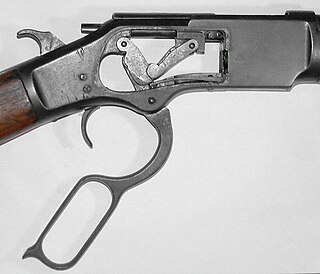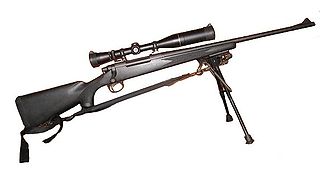
Bolt-action is a type of manual firearm action that is operated by directly manipulating the bolt via a bolt handle, which is most commonly placed on the right-hand side of the firearm.

In firearms terminology, an action is the functional mechanism of a breech-loading firearm that handles the ammunition cartridges, or the method by which that mechanism works. Actions are technically not present on muzzleloaders, as all those are single-shot firearms with a closed off breech with the powder and projectile manually loaded from the muzzle. Instead, the muzzleloader ignition mechanism is referred to as the lock.

Weatherby, Inc. is an American gun manufacturer founded in 1945 by Roy Weatherby. The company is best known for its high-powered magnum cartridges, such as the .257 Weatherby Magnum, .270 Weatherby Magnum, .300 Weatherby Magnum, .340 Weatherby Magnum and the .460 Weatherby Magnum. The company's headquarters is based in Sheridan, Wyoming.
The Steyr Scout is an Austrian bolt-action rifle manufactured by Steyr Mannlicher, and chambered primarily for 7.62 NATO, although other caliber options in 5.56×45mm NATO, .243 Winchester, 6.5 Creedmoor, .376 Steyr and 7mm-08 Remington are also offered commercially. It is intended to fill the role of a versatile, lightweight all-around rifle as specified in Jeff Cooper's scout rifle concept. Apart from the barrel and action, the gun is made primarily of polymers and is designed to be accurate to at least 800 m (870 yd).

A lever action is a type of action for repeating firearms that uses a manually operated cocking handle located around the trigger guard area that pivots forward to move the bolt via internal linkages, which will feed and extract cartridges into and out of the chamber, and cock the firing pin mechanism. This contrasts to other type of repeating actions such as the bolt-action, pump-action, semi-automatic, fully automatic, and/or burst mode actions. A firearm using this operating mechanism is colloquially referred to as a levergun.

The Remington Model 700 is a series of bolt-action centerfire rifles manufactured by Remington Arms since 1962. It is a development of the Remington 721 and 722 series of rifles, which were introduced in 1948. The M24 and M40 military sniper rifles, used by the US Army and Marine Corps, respectively, are both based on the Model 700 design.
The Remington Model 7600 is a series of pump-action centerfire rifles made by Remington Arms. The Model 7600 is a progression from the original Model 760 pump-action rifle which Remington produced from 1952 to 1981. Production of the Model Six began in 1981 and was discontinued in 1987. Production of the Sportsman model 76 began in 1985 and was discontinued in 1987. Production of the model 7600 began in 1987 to present.

SAKO, Limited is a Finnish firearm and ammunition manufacturer located in Riihimäki, Tavastia Proper in southern Finland. It also has owned the Tikka brand of bolt-action rifles since 1983, and is now owned by the Italian firearm holding company Beretta Holding.
The Winchester Model 70 is a bolt-action sporting rifle. It has an iconic place in American sporting culture and has been held in high regard by shooters since it was introduced in 1936, earning the moniker "The Rifleman's Rifle". The action has some design similarities to Mauser designs and it is a development of the earlier Winchester Model 54, itself being based on a Mauser 98–type action.

H&R 1871, LLC, or more commonly known as Harrington & Richardson, is an American brand of firearms and a subsidiary of JJE Capital Holdings. H&R ceased independent production February 27, 2015.

The Remington Model 14 was a pump-action repeating rifle designed for the Remington Arms company by John Pedersen. It is part of a series of rifles that include the Remington Model 14-1/2 and the Remington Model 141.
The Savage Model 110 is a bolt-action repeating rifle made by Savage Arms. It was designed in 1958 by Nicholas L. Brewer. It was patented in 1963. The Model 110 has been in continuous production since that time.
The Remington Model 798 is a bolt-action rifle that was sold by Remington Arms from 2006 until 2008. The gun was made as a hunting rifle. It is composed of an imported Zastava Arms barreled action assembled with a laminated stock after import to the United States. It is based on a Mauser 98 action. It is chambered for .243 Winchester, .308 Winchester, .30-06 Springfield, .270 Winchester, 7mm Remington.Magnum, .300 Winchester.Magnum, .375 H&H Magnum and .458 Winchester Magnum It is drilled and tapped for scope mounts. It can have a barrel length of 22, 24 or 26 inches. It weighs 7 pounds, and has a brown laminated stock. The standard variant costs $599, and the Magnum versions can cost anything between $638 and $839. This is an all-steel, controlled-feed action using a flat-bottom receiver with an integral recoil lug, one-piece bolt with dual locking lugs plus a third safety lug and a bolt guide, full-length extractor, solid steel one-piece bottom iron/magazine box/trigger guard, hinged magazine floor plate, and all of the usual Mauser 98 deluxe features.
The Remington Model 30 is a US sporting rifle of the inter-war period based on the military P14/M1917 Enfield rifle action, which was manufactured for the British and US governments during World War I. Initial specimens used surplus military parts with some modifications in order to consume the stock of parts, though further modifications were made as production progressed and later rifles were produced from newly manufactured parts. Most early rifles were in the military .30-06 calibre used in the M1917 but it became available in a variety of chamberings. It was the first high-powered bolt-action sporting rifle produced by Remington. Some would beg to differ as Remington made the Remington Lee factory sporting rifle from 1899-1909, 1446 were built in a variety of calibers.
Remington Arms Model 600 was a push feed bolt-action rifle produced by Remington Arms from 1964 to 1968. While it is commonly believed that production ended in 1967, according to Remington representatives records indicate that it actually ended in 1968. This Model was the precursor to the Model 660 ; the Model Mohawk 600 ; and the Model 673.
The CZ-550 is a bolt-action hunting rifle series manufactured by Česká zbrojovka Uherský Brod. The CZ 550 series is available with a medium or magnum sized action. The CZ 550 rifle is based on the Mauser 98 rifle.
The Remington Model 8 is a semi-automatic rifle designed by John Browning and produced by Remington Arms, introduced as the Remington Autoloading Rifle in 1905, though the name was changed to the Remington Model 8 in 1911.
The BSA CF2 is a rifle manufactured by the Birmingham Small Arms Company (BSA).
The Model 721 and Model 722 along with the later Model 725 variant are bolt-action sporting rifles manufactured by Remington Arms from 1948 until 1961. The 721/722 replaced the short-lived Model 720. The Model 721/722 is considered to be one of the first modern, economically produced sporting rifles whose design largely continued with the subsequent and highly successful Model 700. Manufactured with high precision, it is known for exceptional accuracy. The bolt and receiver design, based on the Mauser action, is considered one of the strongest ever produced. Samples in excellent condition have become collectible.
Sauer 80, 90 and 92 are bolt-action rifles using a non-rotating bolt with rear-locking lugs expanded against matching lugs inside the rear of the action by rotating the bolt handle down. The rifle is known for having a relatively short-for-the-calibre and very smooth bolt travel and has been described as “The most accurate rifle ever made,” and “These are the smoothest actions you will ever cycle. They are remarkably accurate.” but also for being technically more complicated than the “Gold Standard” Mauser 98 bolt action. The early European and Colt models had a very complicated trigger mechanism and this was later changed in production to a standard shotgun single-set trigger to give adequate safety with simplicity and familiarity of use.










